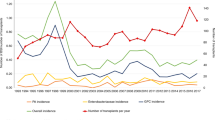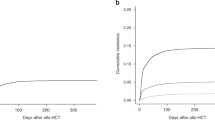Abstract
Bloodstream infection (BSI) is a major infectious complication after allogeneic hematopoietic cell transplantation (HCT). To clarify the impact of graft cell source on the incidence of BSI after transplantation, we retrospectively examined 782 adult patients receiving their first allogeneic HCT: 122 recipients of related peripheral blood stem cells or bone marrow, 215 recipients of unrelated bone marrow, and 445 recipients of unrelated umbilical cord blood (U-CB). The cumulative incidence of BSI was 42.5% at 100 days after transplantation (95% confidence interval, 39.0–46.0). Gram-positive cocci were present in 64.2% of detected isolates. Among the pre-transplant factors including age, performance status, primary disease, disease status, graft cell source, sex and ABO blood type matching, and the intensity of conditioning regimen, U-CB use was identified as the most significant risk factor for BSI by multivariate analysis (hazard ratio, 1.76; 95% confidence interval, 1.40–2.22; p < 0.00001). Among the U-CB recipients, those who are not in remission at the time of transplantation were at the greatest risk of BSI (hazard ratio, 1.69; 95% confidence interval, 1.14–2.50; p < 0.01). The study makes it clear that graft cell source has an impact on BSI development after allogeneic HCT.
This is a preview of subscription content, access via your institution
Access options
Subscribe to this journal
Receive 12 print issues and online access
$259.00 per year
only $21.58 per issue
Buy this article
- Purchase on Springer Link
- Instant access to full article PDF
Prices may be subject to local taxes which are calculated during checkout


Similar content being viewed by others
References
Collin BA, Leather HL, Wingard JR, Ramphal R. Evolution, incidence, and susceptibility of bacterial bloodstream isolates from 519 bone marrow transplant patients. Clin Infect Dis. 2001;33:947–53.
Ortega M, Rovira M, Almela M, Marco F, de la Bellacasa JP, Martinez JA, et al. Bacterial and fungal bloodstream isolates from 796 hematopoietic stem cell transplant recipients between 1991 and 2000. Ann Hematol. 2005;84:40–6.
Almyroudis NG, Fuller A, Jakubowski A, Sepkowitz K, Jaffe D, Small TN, et al. Pre- and post-engraftment bloodstream infection rates and associated mortality in allogeneic hematopoietic stem cell transplant recipients. Transpl Infect Dis. 2005;7:11–7.
Parody R, Martino R, Rovira M, Vazquez L, Vazquez MJ, de la Camara R, et al. Severe infections after unrelated donor allogeneic hematopoietic stem cell transplantation in adults: comparison of cord blood transplantation with peripheral blood and bone marrow transplantation. Biol Blood Marrow Transplant. 2006;12:734–48.
Poutsiaka DD, Price LL, Ucuzian A, Chan GW, Miller KB, Snydman DR. Blood stream infection after hematopoietic stem cell transplantation is associated with increased mortality. Bone Marrow Transplant. 2007;40:63–70.
Mikulska M, Del Bono V, Raiola AM, Bruno B, Gualandi F, Occhini D, et al. Blood stream infections in allogeneic hematopoietic stem cell transplant recipients: reemergence of Gram-negative rods and increasing antibiotic resistance. Biol Blood Marrow Transplant. 2009;15:47–53.
Liu CY, Lai YC, Huang LJ, Yang YW, Chen TL, Hsiao LT, et al. Impact of bloodstream infections on outcome and the influence of prophylactic oral antibiotic regimens in allogeneic hematopoietic SCT recipients. Bone Marrow Transplant. 2011;46:1231–9.
Busca A, Cavecchia I, Locatelli F, D’Ardia S, De Rosa FG, Marmont F, et al. Blood stream infections after allogeneic stem cell transplantation: a single-center experience with the use of levofloxacin prophylaxis. Transpl Infect Dis. 2012;14:40–8.
Bock AM, Cao Q, Ferrieri P, Young JA, Weisdorf DJ. Bacteremia in blood or marrow transplantation patients: clinical risk factors for infection and emerging antibiotic resistance. Biol Blood Marrow Transplant. 2013;19:102–8.
Gudiol C, Garcia-Vidal C, Arnan M, Sanchez-Ortega I, Patino B, Duarte R, et al. Etiology, clinical features and outcomes of pre-engraftment and post-engraftment bloodstream infection in hematopoietic SCT recipients. Bone Marrow Transplant. 2014;49:824–30.
Blennow O, Ljungman P, Sparrelid E, Mattsson J, Remberger M. Incidence, risk factors, and outcome of bloodstream infections during the pre-engraftment phase in 521 allogeneic hematopoietic stem cell transplantations. Transpl Infect Dis. 2014;16:106–14.
Kikuchi M, Akahoshi Y, Nakano H, Ugai T, Wada H, Yamasaki R, et al. Risk factors for pre- and post-engraftment bloodstream infections after allogeneic hematopoietic stem cell transplantation. Transpl Infect Dis. 2015;17:56–65.
Young JH, Logan BR, Wu J, Wingard JR, Weisdorf DJ, Mudrick C, et al. Infections after transplantation of bone marrow or peripheral blood stem cells from unrelated donors. Biol Blood Marrow Transplant. 2016;22:359–70.
Ballen K, Woo Ahn K, Chen M, Abdel-Azim H, Ahmed I, Aljurf M, et al. Infection rates among acute leukemia patients receiving alternative donor hematopoietic cell transplantation. Biol Blood Marrow Transplant. 2016;22:1636–45.
Saavedra S, Sanz GF, Jarque I, Moscardo F, Jimenez C, Lorenzo I, et al. Early infections in adult patients undergoing unrelated donor cord blood transplantation. Bone Marrow Transplant. 2002;30:937–43.
Narimatsu H, Matsumura T, Kami M, Miyakoshi S, Kusumi E, Takagi S, et al. Bloodstream infection after umbilical cord blood transplantation using reduced-intensity stem cell transplantation for adult patients. Biol Blood Marrow Transplant. 2005;11:429–36.
Tomonari A, Takahashi S, Ooi J, Tsukada N, Konuma T, Kobayashi T, et al. Bacterial bloodstream infection in neutropenic adult patients after myeloablative cord blood transplantation: experience of a single institution in Japan. Int J Hematol. 2007;85:238–41.
Cahu X, Rialland F, Touzeau C, Chevallier P, Guillaume T, Delaunay J, et al. Infectious complications after unrelated umbilical cord blood transplantation in adult patients with hematologic malignancies. Biol Blood Marrow Transplant. 2009;15:1531–7.
Yazaki M, Atsuta Y, Kato K, Kato S, Taniguchi S, Takahashi S, et al. Incidence and risk factors of early bacterial infections after unrelated cord blood transplantation. Biol Blood Marrow Transplant. 2009;15:439–46.
Sanz J, Cano I, Gonzalez-Barbera EM, Arango M, Reyes J, Montesinos P, et al. Bloodstream infections in adult patients undergoing cord blood transplantation from unrelated donors after myeloablative conditioning regimen. Biol Blood Marrow Transplant. 2015;21:755–60.
Zheng C, Tang B, Zhu X, Zhang X, Zhang L, Geng L, et al. Pre-engraftment bloodstream infections in acute leukemia patients undergoing unrelated cord blood transplantation following intensified myeloablative conditioning without ATG. Ann Hematol. 2017;96:115–24.
Horan TC, Andrus M, Dudeck MA. CDC/NHSN surveillance definition of health care-associated infection and criteria for specific types of infections in the acute care setting. Am J Infect Control. 2008;36:309–32.
Dandoy CE, Ardura MI, Papanicolaou GA, Auletta JJ. Bacterial bloodstream infections in the allogeneic hematopoietic cell transplant patient: new considerations for a persistent nemesis. Bone Marrow Transplant. 2017;52:1091–106.
Hughes WT, Armstrong D, Bodey GP, Bow EJ, Brown AE, Calandra T, et al. 2002 guidelines for the use of antimicrobial agents in neutropenic patients with cancer. Clin Infect Dis. 2002;34:730–51.
Freifeld AG, Bow EJ, Sepkowitz KA, Boeckh MJ, Ito JI, Mullen CA, et al. Clinical practice guideline for the use of antimicrobial agents in neutropenic patients with cancer: 2010 update by the infectious diseases society of america. Clin Infect Dis. 2011;52:e56–93.
Bacigalupo A, Ballen K, Rizzo D, Giralt S, Lazarus H, Ho V, et al. Defining the intensity of conditioning regimens: working definitions. Biol Blood Marrow Transplant. 2009;15:1628–33.
Giralt S, Ballen K, Rizzo D, Bacigalupo A, Horowitz M, Pasquini M, et al. Reduced-intensity conditioning regimen workshop: defining the dose spectrum. Report of a workshop convened by the center for international blood and marrow transplant research. Biol Blood Marrow Transplant. 2009;15:367–9.
Kanda Y. Investigation of the freely available easy-to-use software ‘EZR’ for medical statistics. Bone Marrow Transplant. 2013;48:452–8.
Dandoy CE, Kim S, Chen M, Ahn KW, Ardura MI, Brown V, et al. Incidence, risk factors, and outcomes of patients who develop mucosal barrier injury-laboratory confirmed bloodstream infections in the first 100 days after allogeneic hematopoietic stem cell transplant. JAMA Netw Open. 2020;3:e1918668.
Ge J, Yang T, Zhang L, Zhang X, Zhu X, Tang B, et al. The incidence, risk factors and outcomes of early bloodstream infection in patients with malignant hematologic disease after unrelated cord blood transplantation: a retrospective study. BMC Infect Dis. 2018;18:654.
Yanada M, Takami A, Yamasaki S, Arai Y, Konuma T, Uchida N, et al. Allogeneic hematopoietic cell transplantation for adults with acute myeloid leukemia conducted in Japan during the past quarter century. Ann Hematol. 2020;99:1351–60.
Bejanyan N, Brunstein CG, Cao Q, Lazaryan A, Luo X, Curtsinger J, et al. Delayed immune reconstitution after allogeneic transplantation increases the risks of mortality and chronic GVHD. Blood Adv. 2018;2:909–22.
Schots R, Trullemans F, Van Riet I, Kaufman L, Hafsia A, Meddeb B, et al. The clinical impact of early gram-positive bacteremia and the use of vancomycin after allogeneic bone marrow transplantation. Transplantation. 2000;69:1511–4.
Kimura S, Akahoshi Y, Nakano H, Ugai T, Wada H, Yamasaki R, et al. Antibiotic prophylaxis in hematopoietic stem cell transplantation. A meta-analysis of randomized controlled trials. J Infect. 2014;69:13–25.
van Burik JA, Carter SL, Freifeld AG, High KP, Godder KT, Papanicolaou GA, et al. Higher risk of cytomegalovirus and aspergillus infections in recipients of T cell-depleted unrelated bone marrow: analysis of infectious complications in patients treated with T cell depletion versus immunosuppressive therapy to prevent graft-versus-host disease. Biol Blood Marrow Transplant. 2007;13:1487–98.
Maung KK, Horwitz ME. Current and future perspectives on allogeneic transplantation using ex vivo expansion or manipulation of umbilical cord blood cells. Int J Hematol. 2019;110:50–8.
Acknowledgements
The authors thank the patients and the donors. We also thank physicians, nurses, pharmacists, transplantation coordinator (Ms. Madoka Narita), data managers (Ms. Rumiko Tsuchihashi and Ms. Kaori Kobayashi), other co-medical staffs, and support personnel for their care of the patients involved in the study.
Author information
Authors and Affiliations
Contributions
S. Takagi is the principal investigator and takes primary responsibility for the paper; S. Takagi wrote the manuscript; S. Takagi, NU, TM, MY, KK, DK, YT, AN, K. Ishiwata., H.Y., G.Y., Y.A-M, K. Izutsu., AW and S. Taniguchi treated patients and reviewed the final manuscript; SO, HA, MK, YK and SM reviewed the final manuscript; S. Takagi, AY, and S. Taniguchi designed the research; AY and S. Taniguchi organized the project.
Corresponding author
Ethics declarations
Conflict of interest
The authors declare no competing interests.
Additional information
Publisher’s note Springer Nature remains neutral with regard to jurisdictional claims in published maps and institutional affiliations.
Rights and permissions
About this article
Cite this article
Takagi, S., Ogura, S., Araoka, H. et al. The impact of graft cell source on bloodstream infection in the first 100 days after allogeneic hematopoietic cell transplantation. Bone Marrow Transplant 56, 1625–1634 (2021). https://doi.org/10.1038/s41409-021-01229-6
Received:
Revised:
Accepted:
Published:
Issue Date:
DOI: https://doi.org/10.1038/s41409-021-01229-6
This article is cited by
-
Post-transplantation cyclophosphamide is associated with increased bacterial infections
Bone Marrow Transplantation (2024)
-
Hematopoiesis in the spleen after engraftment in unrelated cord blood transplantation evaluated by 18F-FLT PET imaging
International Journal of Hematology (2023)
-
Clinical implications of augmented renal clearance after unrelated single cord blood transplantation in adults
International Journal of Hematology (2023)
-
Clinical and microbiological characteristics of bacterial meningitis in umbilical cord blood transplantation recipients
International Journal of Hematology (2022)



